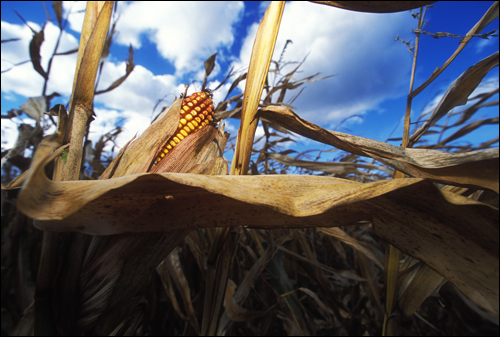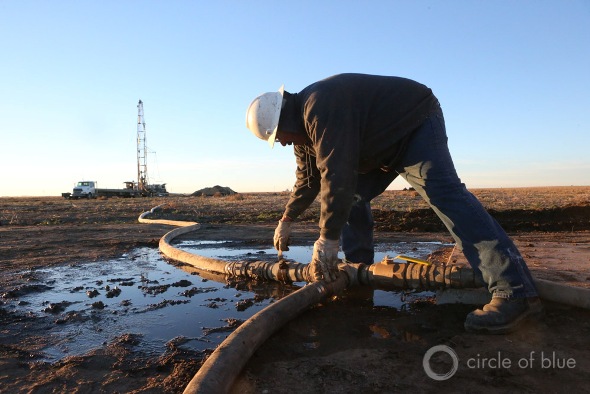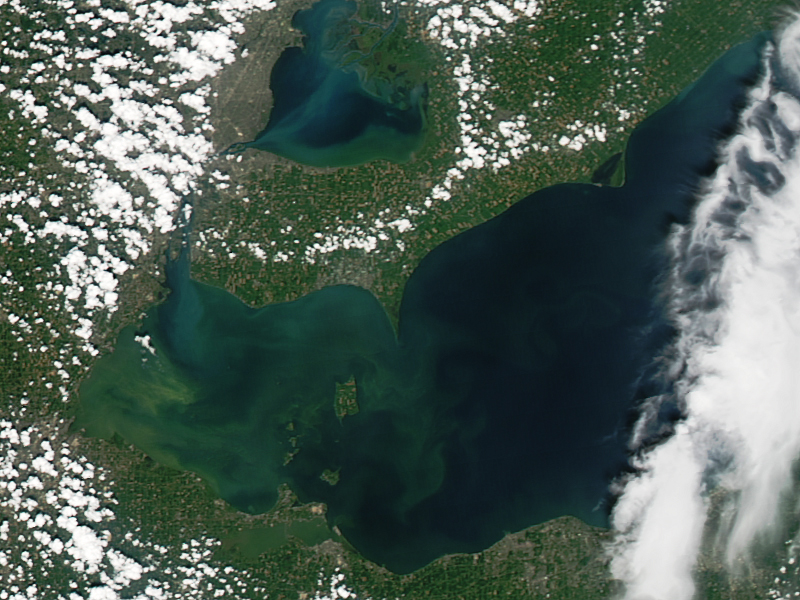Environmental Groups Face Off With EPA to Control Manure Pollution
Ninth Circuit Appellate Court Hears Arguments to Compel Federal Action

Cary Pioneer Farms sits on the outskirts of Alma, Michigan. It is one of 27 CAFOs in Gratiot County. Photo © J. Carl Ganter / Circle of Blue
By Keith Schneider, Circle of Blue
September 14, 2024 – updated on October 15, 2024
For the third time in two decades the Environmental Protection Agency appeared in federal Appellate Court this week to defend its admittedly flawed approach to regulating the billions of pounds of manure running off into the nation’s waters from large industrial animal feeding operations. But unlike the previous Appellate Court cases in 2005 and 2011, when the plaintiffs were the major agricultural trade organizations seeking to weaken or eliminate agency regulations, this time the case was brought by 13 national and local environmental organizations arguing that after years of inaction EPA needs to drastically strengthen its oversight.
The argument made by Food and Water Watch and its allies is this: The EPA is unlawfully allowing roughly half of the nation’s more than 20,000 big livestock and poultry feeding facilities around the country to operate without permits required under the 1972 Clean Water Act. And the agency is violating the law by authorizing the big feedlots, known as concentrated animal feeding operations (CAFOs) to store and spread manure so haphazardly that drinking water for millions, and thousands of streams and lakes are being polluted with bacteria, nitrates, phosphorus and other contaminants.
“CAFOs are illegally discharging to waterways and have become a major source of unregulated point source pollution,” argued Emily Miller, attorney for Food and Water Watch, the lead plaintiff. “EPA has further admitted that its regulations have proven insufficient to compel Clean Water Act compliance and even stand in the way of effective enforcement.”
EPA attorney Paul Cirino did not dispute those assertions. But he told the three judge panel of the Ninth Circuit Court of Appeals that EPA initiated a detailed study of CAFO operations and pollution in January, and the agency established a study group last summer that is scheduled to issue recommendations on CAFO oversight next year. The new information, he said, would guide the agency’s actions about how to respond to the environmental groups’ concerns.
The court’s decision is expected within months.

Algal blooms caused by runoff pollution can be toxic. Photo © J. Carl Ganter/ Circle of Blue
Years of Inaction
The hearing today comes as the number of CAFOs and the amount of manure they generate grows, along with evidence of mounting pollution. That, in turn, is prompting increasing numbers of civic campaigns to halt CAFO development in their regions. “Things have really changed and there is definitely more activist attention than a decade ago, when I was in Iowa,” said Carrie La Seur, legal director for For Love of Water (FLOW), an environmental group in Traverse City, Michigan. “People recognize CAFOs are a big problem and something systemic needs to be done.”
In every state that big livestock and poultry facilities operate health and environmental authorities have documented manure discharges that contaminate streams, lakes, and drinking water with E. coli, a dangerous bacteria, phosphorus, and nitrates, which have been linked to cancer, and lead to waterways choked by toxic algae blooms.
In Iowa, for example, half of all lakes, reservoirs, and river and streams tested are impaired, and the state’s cancer incidence ranks second highest in the nation and is rising. Nitrate contamination in Michigan’s groundwater is worst in regions with the largest concentrations of CAFOs, according to state data.
Manure from industrial dairies, and hog and poultry feeding operations have produced persistent toxic algae blooms in Lake Erie, Lake Champlain, and other iconic water bodies. The federal government has spent $30 billion since 1997 on voluntary farm practices to stem the flow of nitrates from crop production and livestock manure in 12 Mississippi River Basin states. Nitrate contamination in the river is getting worse.

In northwest Wisconsin, three counties and seven townships have approved new ordinances since 2016 to establish standards for managing and operating CAFOs that are not addressed by the state Department of Natural Resources. Photo © J. Carl Ganter/ Circle of Blue
More Animals, More Manure
In every meat and milk production sector, the concentration of cows, hogs, chickens, and turkeys is increasing. In North Carolina, for example, nearly 357 million chickens and turkeys were housed on factory farms in North Carolina in 2022 – 107 million more and a 43 percent increase since 2007. They produce 3.2 million tons of manure annually that contains nitrogen, phosphorus and dangerous pathogens, according to an investigation by the Environmental Working Group made public this week.
Overall, according to the 2022 Census of Agriculture, 1.7 billion animals are raised in industrial feeding operations, nearly 50 percent more than in 2002. They are raised in over 20,000 factory farms and annually generate nearly 1 trillion pounds of manure, 500 million tons, according to an analysis by Food and Water Watch. That is more than a third of the 1.4 billion tons of manure produced each year in the U.S., according to the Department of Agriculture.
The EPA has sought in recent years to more aggressively address the pollution from CAFOs. It’s issued orders to state officials and individual CAFOs in four states — Minnesota, Oregon, Washington, and Wisconsin — to take action to halt manure runoff into ground and surface waters.
The latest action occurred in Vermont last week when the agency warned in a letter to state officials that unless the two state agencies charged with overseeing CAFOs rapidly strengthen their regulatory programs the federal agency will assume the duties. The agency’s action follows a petition to the EPA from the Conservation Law Foundation and two other non-profit groups for a federal investigation that found glaring weaknesses in the CAFO oversight program, which is managed by the Vermont Department of Natural Resources and the state Agriculture Department. The EPA said the division of labor between the two departments is a primary flaw in state oversight.
Grassroots Campaigns
The results of such orders is mixed, leading to mounting civic campaigns to halt CAFO pollution in many states. In Iowa, Driftless Water Defenders, a non-profit advocacy group that formed in May, sued local county supervisors two months later in state District Court over their decision to rezone land to build a biodigester to convert manure from two large dairies into methane.
In northwest Wisconsin, three counties and seven townships have approved new ordinances since 2016 to establish standards for managing and operating CAFOs that are not addressed by the state Department of Natural Resources. They include requirements for a CAFO operating permit that direct operators to submit plans for carefully storing and spreading manure, reducing air contaminants, reporting water use, and posting a bond to pay for cleanup if they go out of business. The ordinances were developed from a model prepared by a local committee. “This kind of coordinated effort is the only way we’re ever going to take on an industry that wants no regulation,” said Lisa Doerr, a farmer in Laketown and the committee chair.
The case in the Ninth Circuit Appellate Court today stems from a petition filed by Food and Water Watch and other groups in 2017 to compel the E.P.A. to strengthen how it regulated CAFO wastes under the Clean Water Act. The petition specifically called for the EPA to require CAFOs to obtain water quality permits and strengthen permit standards so that manure does not pollute water. The petition also urged the agency to reconsider an exemption that immunizes CAFOs from any water pollution caused by storms washing manure off of saturated fields.
The Trump administration ignored the petition. But last summer the EPA finally addressed the issue. It denied the petition, but announced that it would form a committee to recommend any changes in how the agency regulated CAFOs. Weeks later Food and Water Watch, joined by four other national organizations and eight environmental groups from five states, sued the EPA to reconsider its decision.
Their argument centers on the agency’s own admission that its CAFO regulatory program is weak, in part due to rulings in the previous appellate cases that restricted its authority. “Many CAFOs are not regulated and continue to discharge without NPDES permits because successive court decisions have severely limited EPA’s ability to require CAFOs to obtain an NPDES permit,” wrote the authors of an EPA report in 2022 (p.74). “The regulations contain definitions, thresholds and limitations that make it difficult to compel permit coverage, limit the discharge of pollutants under certain circumstances, and enforce requirements even when discharges have been established.”
“EPA has admitted that its current regulations have failed to address problem and even stand in the way of effectuating the Clean Water Act,” said Food and Water Watch attorney Miller, in an interview. “But it still denied our petition. Its reasons for doing so are completely unreasonable given the obvious need to update the rules.”
Circle of Blue’s senior editor and chief correspondent based in Traverse City, Michigan. He has reported on the contest for energy, food, and water in the era of climate change from six continents. Contact
Keith Schneider













Leave a Reply
Want to join the discussion?Feel free to contribute!